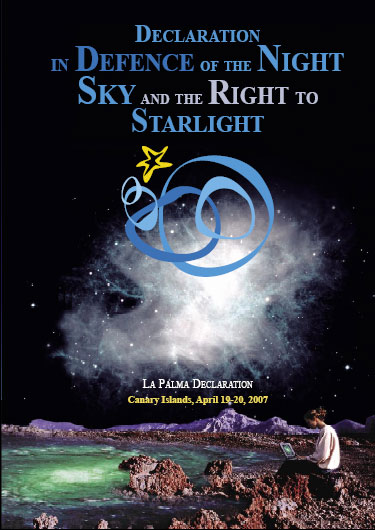New Brochure of UNESCO`s MAB Programme partnership
Alternative ways of Lighting the UNESCO Sites: Save Energy and Recover the Stars!
 Published by Starlight Foundation with the support of iGuzzini
Published by Starlight Foundation with the support of iGuzzini
CHAPTERS
Light and the stars
Recovering our vision of the starry sky
At present most people in the world do not have the possibility to see the Milky Way and its stars in the sky, including astronomers. The increase in light pollution is blotting out the stars from our sky, causing the deterioration of a legacy with strong cultural, scientific, environmental and aesthetic repercussions. Clear night skies also provide sustainable income opportunities as tourists and visitors are eagerly looking for sites with impressive night skies.
Light and life
Protecting biodiversity and people’s health
Light pollution has a negative effect on many species of plants and animals, including migratory species, both in protected areas and in urban or rural areas. Too much light can affect people’s health, by changing circadian rhythms. Thus, reducing the emission of artificial light may help to protect biodiversity and improve health conditions for the general population.
Light and heritage
Preserve skyscapes and associated cultural and scientific values
When we look up at a dark night sky, we are essentially seeing the same sky that humans have looked upon for thousands of years. It is the same sky that has motivated cultures from around the world. For uncountable generations human beings have looked at the starry sky like a source of inspiration for the most diverse aspects of their cultural heritage.
UNESCO designated sites
Towards a new culture of light
Reducing light pollution, saving energy and recovering starry sky should be part of a new culture on the UNESCO sites protection committed to acting on climate change and sustainable development. Eight years after the Declaration of La Palma (Declaration in Defence of the Night Sky and the Right to Starlight), over thirty biosphere reserves, world heritage sites and geoparks have now developed successful initiatives to ensure night sky quality and promote sustainable lighting.
Prevent Light Pollution
Promoting outdoor lighting with intelligent options
This would be based around three simple principles. First, only illuminate what needs to be illuminated. Second, make use of outdoor lighting only when needed. Finally, use luminaires that completely avoid light emissions towards the horizon or up to the sky. It is absurd to waste energy sending light to the stars.
Fostering Innovation
The future of lighting
“Today, LED lighting technology has come of age and is able to deliver benefi ts to cities and citizens alike. It offers more controllable and higher quality light, enhanced visual performance and improves the ambience and safety of urban environments. Moreover, LED lighting will make our cities ‘greener’ by saving up to 70% of lighting energy and reducing costs compared to existing lighting infrastructures. The larger roll-out of intelligent LED lighting systems in cities will be part of the creation of sustainable smart cities: cities where lighting innovation is interlinked to other smart city networks (communications, renewable energy, building or traffic management systems).” Neelie Kroes, Commission Vice-President for the Digital Agenda for Europe.
Light and the climate
Sustainable lighting and climate change
The over-illumination has become a growing phenomenon in many towns and cities around the world. Inefficiency and excess of artificial light increases energy consumption and is economically unjustified. It also increases the level of emissions that contribute to climate change. By contrast, today more than 1.3 billion people worldwide do not have access to basic electricity.
Learning sites for sustainable lighting
At least thirty UNESCO sites worldwide have adopted specific commitments on the protection of the night sky and light pollution control. These places can be understood as learning sites for the development of intelligent lighting solutions and the integration of night sky quality in their conservation policies.
On the ocassion of International Year of Light (IYL2015)
Download Brochure - pdf
English version (Low resolution)
English version (Hight resolution)
Spanish version (Low resolution)
Spanish version (Hight resolution)
Read the publication on Issuu

(*)Edited by: Cipriano Marín (Coordinator of Starlight Initiative). Contributors: Piergiovanni Ceregioli (iGuzzini), Eduardo Fayos-Solá (Ulyses Foundation) and Antonio Gallardo Campos (UNESCO Fuerteventura Biosphere Reserve).
Sponsored by:
![]()
| < Prev | Next > |
|---|
LOOKING FOR SOMETHING?


Starlight Initiative collaborates with the
PORTAL TO THE HERITAGE OF ASTRONOMYUpdates
- New Brochure of UNESCO`s MAB Programme partnership
- Galicia adopts the Starlight Declaration
- Starlight at the 39th session of the World Heritage Committee
- International declaration warning about the effects of blue-rich white light
- Flyer - Starlight Initiative in partnership with the UNESCO MAB Programme
- Astronomical Heritage - Hawaii 2015
- 2015 International Year of Light
- Montsec - Starlight Destination and Reserve
Starlight Finder
Starlight related links
![]()
Covenant of Mayors Related Initiative
![]()
Colaborating with IAU Working Group
![]()
IUCN Dark Sky Advisory Group
![]()
Dark Skies Awareness Project
![]()
Partnership Unesco-MaB
![]()
Member of the Knowledge Network
![]()
Instituto de Astrofísica de Canarias
|
The Starlight Initiative is designed as an international action in defence of the values associated with the night sky and the general right to observe the stars. It is open to the participation of all scientific, cultural, environmental, and citizens' organizations... |
In partnership with: |
|
|
|


